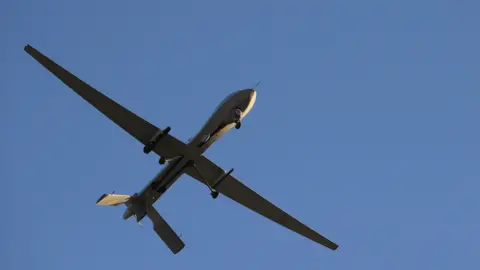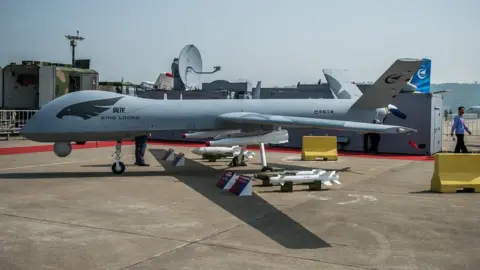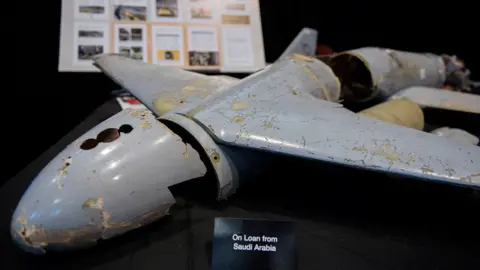Saudi oil attacks: Who's using drones in the Middle East?
 Getty Images
Getty ImagesThe attacks on Saudi oil installations have led to speculation that armed drones were involved.
Both the United States and the Saudi authorities say this may well have been the case.
The offensive use of drones or unmanned aerial vehicles (UAVs) has grown significantly in recent years, and nowhere more so than in the Middle East.
So who has them and who has used them in combat?
A new weapon
The first combat use of an armed drone came in October 2001, on the first night of the Afghan War against a Taliban convoy.
 AFP
AFPArmed UAVs were initially the preserve of a few technologically advanced nations, with Israel and the United States very much in the lead.
Soon a new provider came onto the scene - China, eager to sell its weaponry around the world.
The Chinese have boosted the spread of military drones in the Middle East, selling weaponry to at least half a dozen governments.
The civilian UAV market has also become more sophisticated, and the technology has been converted into combat drones.
While the technology might not be cutting edge, highly capable UAVs can be manufactured by any country with a reasonable industrial base - Iran being a good case in point.
And Iran has played a key role in transferring relatively advanced drone technology to several non-state actors, such as the Houthi rebels in Yemen.
Who has what?
The Middle East is one of the epicentres of the war on terror. It has drawn in technologically advanced players like the United States, Britain and Russia.
There is a host of regional rivalries. The most pronounced fault-line is between Israel and the Gulf Arab states on the one hand, and Iran, its allies and proxies like Hezbollah and the Houthis, on the other.
USA
The US has used armed drones extensively in the Middle East, as part of its campaigns against both al-Qaeda and so-called Islamic State (IS).
Weapons such as Predator and Reaper drones have been used against targets in Syria, Iraq, Libya and Yemen.
The MQ-9 Reaper is a larger, heavier and more capable aircraft than the Predator, capable of carrying a significantly larger weapons payload with a much longer range.
As one of Washington's closest military allies, Britain purchased a number of Reaper systems from the US, and has operated them extensively against targets in both Iraq and Syria.
Israel
Long-acknowledged as one of the pioneers in UAV technology, Israel is one of the major exporters of unarmed UAVs, accounting for - according to one 2018 study - about 60% of the global market.
Among others customers, it has sold surveillance drones to Russia, and has even shot at least one down when it crossed into Israeli territory from Syria.
Israel uses a varied fleet of UAVs for intelligence gathering, surveillance and attack missions.
Its armed drones include the Heron TP, the Hermes 450 and the Hermes 900.
But Israel has been reluctant to export these armed drones.
 AFP
AFPIran
Despite the arms embargo and sanctions, Iran has developed a capacity to build reasonably sophisticated armed UAVs.
The Shahed-129 was unveiled in 2012 and has been used to hit IS and targets in Syria and Iraq. The Mohajer 6 has been in production since 2018.
But the other aspect of Iran's drone programme is its willingness to sell or transfer its technology to its allies and proxies in the region.
Other countries
The United Arab Emirates (UAE) has deployed a fleet of Chinese-supplied Wing Loong 1 UAVs, which have been used against targets in Yemen and in the civil war in Libya.
The UAE backs the faction led by General Haftar. Turkish drones have been used in Libya in support of the Government of National Accord.
Unable to buy American UAVs, Turkey builds its own, which have been used in strikes against Kurdish targets both inside Turkey and in Syria.
Iraq, Jordan, Saudi Arabia, Egypt and Algeria have all purchased Chinese UAVs.
 Getty Images
Getty ImagesUse by militant groups
Houthi rebels are among the most adept UAV users among the non-state actors. They operate a number of systems which, according to UN and other experts, depend heavily on Iranian technology. The Houthis have used the Qasef-1, which a UN panel of experts has determined is virtually identical to an Iranian model.
These are effectively "kamikaze" drones that are deliberately crashed into their targets. A subsequent UN report highlighted the Houthis' use of a more sophisticated UAV-X drone, sometimes referred to as the Samad-2/3, which is believed to have a small explosive warhead.
Lebanese Shia Muslim militant group Hezbollah has operated a small number of what appear to be Iranian-supplied drones.
The war in Syria saw the first significant use of drones in a major swarm attack intended to overwhelm air defences. Rebel forces have directed several drones at major Russian military bases in Syria.
What are the consequences for the region?
It's clear that armed drone technology has spread widely.
Paradoxically, US reluctance to sell advanced UAVs to its allies has not removed the possibility of drone proliferation, because China has stepped in to market its broadly equivalent technology.
Using UAVs to strike at targets has helped to open up a new kind of combat, blurring the line between war and peace.
UAVs have offered the potential to strike precise targets with limited side-effects (at least if the intelligence guiding them is right).
The armed drone or UAV seemed tailor-made for the so-called war against terror. But it was also tailor-made for the sorts of unequal struggles in the region between technologically advanced and far less advanced players.



